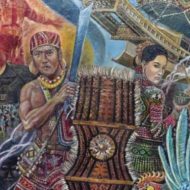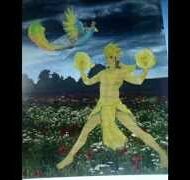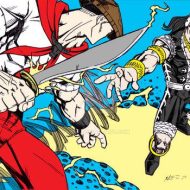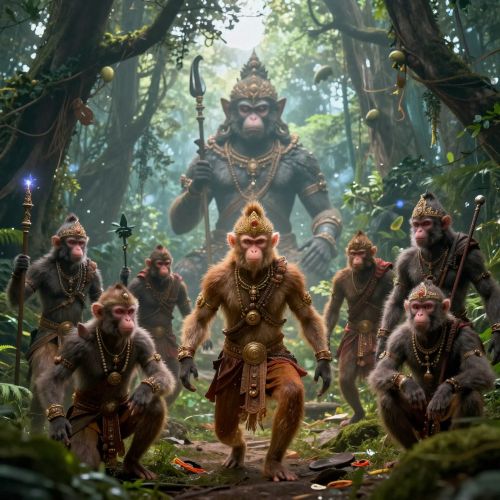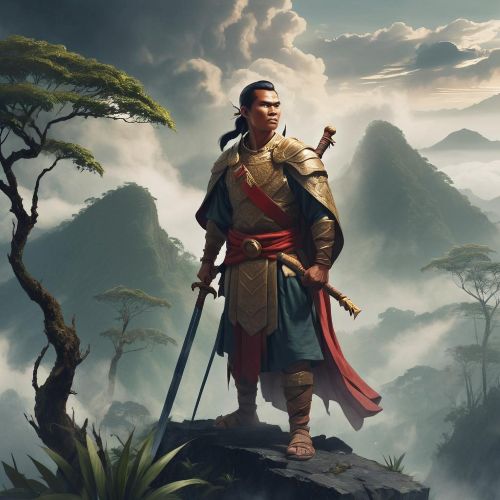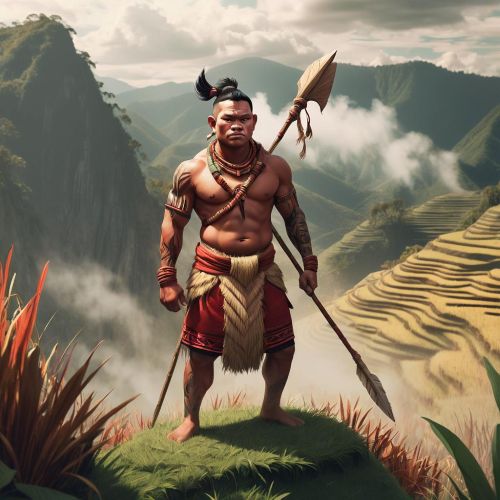Tuwaang : The Heroic Craftsman of Mindanao
Listen
At a glance
| Description | |
|---|---|
| Origin | Philippine Mythology |
| Classification | Mortals |
| Family Members | Maiden of Monawon (Wife) |
| Region | Philippines |
| Associated With | Craftsmanship, Warfare |
Tuwaang
Introduction
Tuwaang is the epic hero of the Manobo people located on the central part of Mindanao, about eighty kilometers by road and trail northwest of Davao city. He is believed to be a one man campaign against evil and to protect his people.
He does farming for his people and he is treated as a leader or a Bagani, a warrior who has taken many human lives. He is also a craftsman as seen in the first epic song where it is mentioned that “he is experienced in making leglets, engraving finger rings, and moulding chains”. In other words, he is a blacksmith, which played an important role in their society.
Physical Traits
Krahang is described with distinct physical characteristics that set him apart from other mythical beings. He is typically depicted as a tall and thin figure with dark skin and a visage that can appear both handsome and ghostly. One of the defining physical traits of Krahang is his ability to emit light in the dark, often assumed to be a manifestation of his supernatural powers. In some accounts, Krahang is portrayed as having wings that allow him to travel at night, reinforcing his reputation as an aerial spirit. He is often illustrated wearing a traditional Thai garment called a “chong kraben” along with a distinctive headpiece.
Family
He is known to have married the Maiden of Mo:nawon in the story “Tuwaang attends a wedding”. In many tales, Krahang is said to be part of a larger family of spirits known as “Phi,” which encompasses a broad spectrum of supernatural beings in Thai mythology. His precise familial connections can vary between tales, with some suggesting he has siblings who also possess supernatural qualities.
Powers and Abilities
According to the legend, he has supernatural abilities that are bestowed upon him because of the clothes made from heavenly materials that he wears. He can teleport using lightning or use his anthropomorphic bird. He also had the use of the magic betel nut, the magic skin of gold, and the special clothes beaded by the goddesses. He is also known to have command over the wind and lightning.
Krahang’s powers are an integral part of his character, lending him both intrigue and fear. Among his most notable abilities is the capability to fly, allowing him to traverse vast distances quickly. This ability contributes to his association with nighttime and the supernatural realms. In some tales, Krahang is believed to possess the power of invisibility, enabling him to escape capture or observation.
Another significant aspect of Krahang’s abilities is his deep connection to nature and the elemental forces. He is sometimes associated with fertile lands, and local folklore suggests that he can influence crops and livestock. His significance is intertwined with agricultural practices in rural Thailand, where his blessings are sought for successful yields.
Additionally, Krahang is said to have the power to shape-shift, transforming into different forms to trick or engage with humans. This ability underscores the dual nature of Krahang, simultaneously representing benevolence and malice.
Modern Day Influence
Several novels and literary work have stemmed from the legend of Tuwaang including “Malakas at Maganda”,“Bongkatolan –the woman warrior, “Epic of Tuwaang Saving the Maiden of the Buhong Sky”, “Tuwaang Saving the Maiden of Monawon from the Deathless Man”, “Epic of Lam-Ang”, “Tale of Banna” and “The Story of the Golden Rice from the Skyworld.”He
Related Images
Source
Manuel, E. A. (1958). The maiden of the Buhong Sky: A complete song from the Bagobo folk epic “Tuwaang.” University of the Philippines Press.
Manuel, E. A. (1975). Tuwaang attends a wedding: The second song of the Manuvu’ ethno-epic Tuwaang. Ateneo de Manila University Press.
Manuel, E. A. (1963). A survey of Philippine folk epics. Asian Folklore Studies, 22(1), 1–95. https://doi.org/10.2307/1177648
Philippine Cultural Education. (n.d.). Tuwaang: Hero of the Tuwaang epics of the Bagobo. Retrieved November 8, 2025, from https://philippineculturaleducation.com.ph/tuwaang-hero-of-the-tuwaang-epics-of-the-bagobo/
Ramose, M. (2025, February 2). Epic of Tuwaang. WordPress. Retrieved November 8, 2025, from https://marleneramose122e5848d3.wordpress.com/2025/02/02/epic-of-tuwaang/
University of Wisconsin–Madison. (n.d.). A survey of Philippine folk epics [PDF]. Asian Ethnology Archive. Retrieved November 8, 2025, from https://asianethnology.org/downloads/ae/pdf/a140.pdf
Cabigon, M. (2024). Epic-chanting and the figure of Pantaron Manobo “breath” goynawa. ResearchGate. https://www.researchgate.net/publication/354178333_Epic-chanting_and_the_figure_of_Pantaron_Manobo_breath_goynawa
Frequently Asked Questions
Who is the author of Tuwaang?
E. Arsenio Manuel is the author of “Tuwaang,” an epic centered around the Bagobo, an indigenous community in southern Mindanao. During the late 1950s to 1970s, Manuel successfully obtained and released two songs titled “The Maiden of the Buhong Sky, A Complete Song from the Manuvu Bagobo Folk Epic Tuwaang” and “Tuwaang Attends a Wedding.” Saddani Pagayaw, a key informant, collaborated with Manuel, having acquired the epics from the bard Inuk.
What are the characteristics or supernatural powers of Tuwaang?
Tuwaang, the Manobo epic hero, stands out with his extraordinary supernatural abilities. He can teleport through lightning, wield the wind and lightning, and even transform into animals. Alongside his magical items, these powers make him a formidable warrior. But Tuwaang is more than just brawn – he’s also wise, kind, and skilled in craftsmanship. These qualities, combined with his supernatural gifts, solidify Tuwaang as a legendary figure, forever inspiring generations with his courage and devotion to protecting his people.
What is the moral lesson of Tuwaang attends a wedding?
The Manobo epic “Tuwaang Attends a Wedding” offers a multifaceted moral lesson. Through Tuwaang’s downfall caused by jealousy and impulsiveness, it warns against underestimating others, respecting traditions, and wielding power responsibly. While highlighting the dangers of jealousy, it also suggests that true love can blossom beyond initial attraction. Ultimately, the story serves as a cautionary tale, urging us to think before we act and to use our abilities for good.
What is the story of Tuwaang?
The epic of Tuwaang, a Manobo hero, is a grand adventure tale passed down through generations. Possessing extraordinary abilities like teleportation and flight, Tuwaang embarks on a series of fantastical journeys, battling mythical creatures and powerful enemies. He faces love and loss, transforming into a hero who inspires future generations with his bravery and dedication to protecting his people. This ever-evolving epic celebrates heroism, justice, and the rich cultural tapestry of the Manobo community.
What tribe is Tuwaang?
Tuwaang is the legendary hero from the Manobo tribe. The Manobo people are an indigenous group found in the southern Philippines, primarily in the Mindanao and Palawan islands. They are known for their rich oral traditions, including the epic cycle of Tuwaang, which celebrates their cultural values and history.


